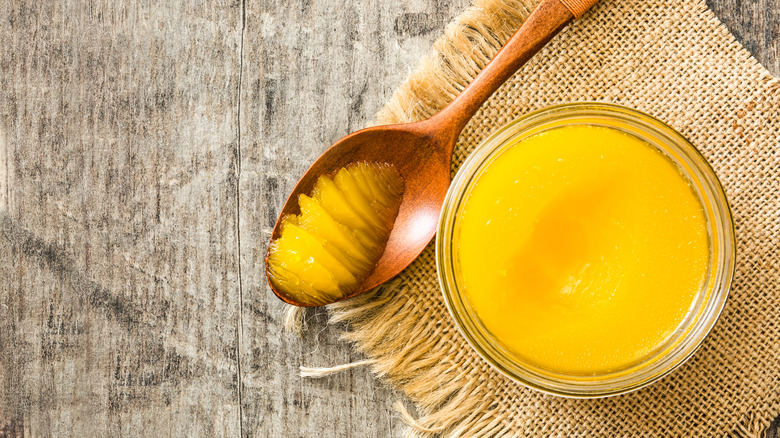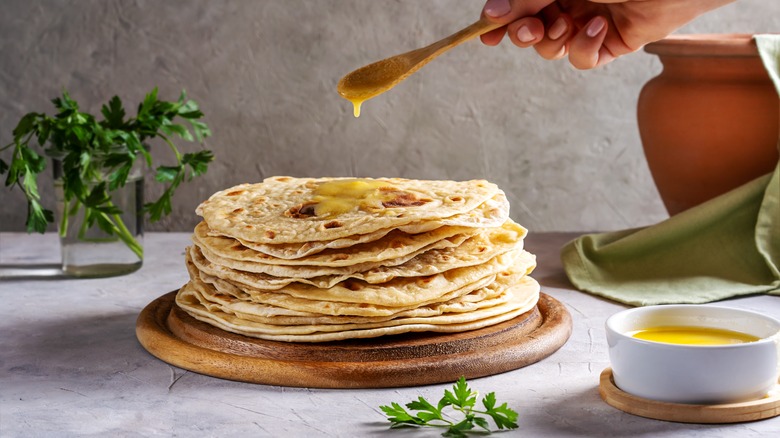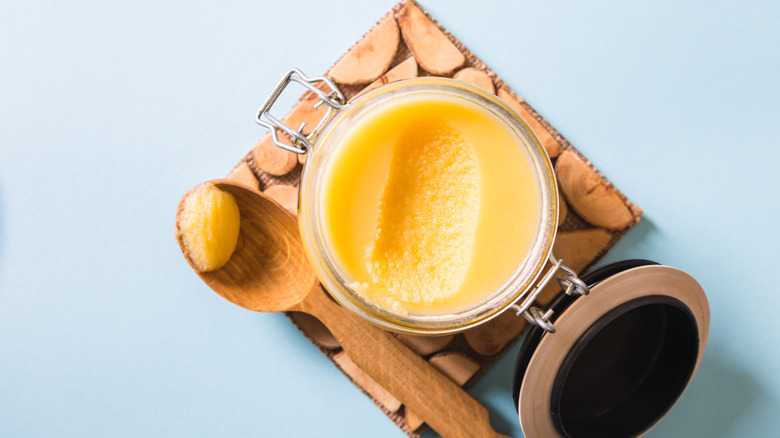What's The Difference Between Ghee And Clarified Butter?
Ghee and clarified butter tend to be fairly interchangeable in many peoples' minds, and it makes sense why. They're both jarred, shelf-stable ingredients that appear similar in color and texture. Plus, both work great for roasting or sautéing thanks to their high smoke point. And they're both considered healthier versions of butter, for one reason or another.
You might notice one sitting on your grocery store shelf, or the other in the ingredients list of a recipe you're making. But if ghee and clarified butter seem similar enough, and they're used in many of the same ways, does it really matter which one you go with? How are the two actually any different?
The differences between ghee and clarified butter are subtle, but if you'd like to put either of them to use in the kitchen, it's helpful to know what those subtleties are. It all comes down to three main distinctions: the way it's made, its origins, and its flavor.
Ghee and clarified butter: differences in production and origin
Clarified butter is made by simmering butter until its milk solids separate and sink to the bottom, then removing those milk solids from the butter. What you're left with is what's referred to as liquid gold — no more water and no more milk proteins, just clarified butter (aka pure butter fat) that will last up to a year in the fridge and can withstand much higher heat before reaching its smoke point.
Ghee is a specific type of clarified butter (so all of the above remains true), except there's an extra step involved. To make ghee, instead of removing the milk solids from the clarified butter right away, you keep cooking them until they start to caramelize to a golden brown — and then you strain the liquid. It's essentially the brown butter of clarified butters.
Clarified butter is most often associated with French cooking; it's typically used to preserve or fry foods or as an ingredient in sauces like Béarnaise and Hollandaise. In France, clarified butter was most likely originally used for its high smoke point, to achieve certain culinary purposes. Ghee, on the other hand, originated in ancient India and is found in traditional Indian dishes, like butter chicken and various curries. It was originally created as a means of extending the shelf life of butter, a necessity in India's warm climate.
Ghee and clarified butter: differences in flavor
Because of the nuances in how they're made, the main difference between clarified butter and ghee lies in their flavor. Clarified butter, as a pure form of butter fat, has an intense, concentrated butter flavor and a cleaner finish since it's not quite as heavy or creamy as regular butter. It's all that butter flavor you love, undiluted by water or milk.
With ghee, that extra step of browning and toasting the milk proteins results in an even richer flavor profile than regular clarified butter. Ghee has a deeper, nuttier, almost caramel-like flavor and aroma.
Because they come with different flavor profiles, clarified butter and ghee tend to complement different ingredients. So how can you use their differences to your advantage? Try the clean, buttery taste of clarified butter for sautéeing fish or dipping seafood, drizzle it on your popcorn, or use it in hearty dishes like risotto and pasta. While ghee compliments the warm, flavorful spices of Indian food deliciously, it can expand far beyond Indian cuisine — use it to flavor things like rice, mashed potatoes, or stewed carrots, or as a butter replacement in baked goods like cookies, cakes, and pie crusts.


